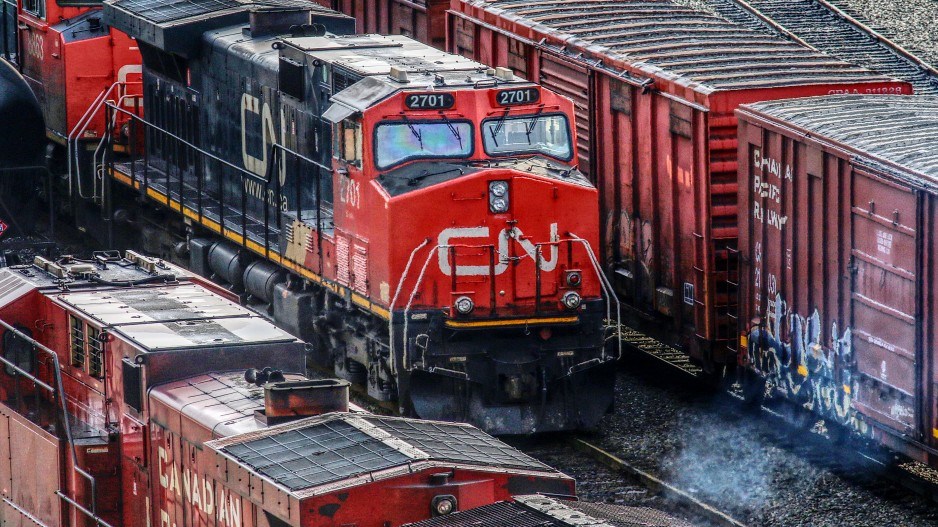B.C.’s Asia-Pacific Gateway needs overhauling. 2023’s West Coast dockworker contract conflict is one example, but more than labour relations and human resource availability need fixing now.
A new RBC Economics report provides insight into the range of investment and improvements required to keep that gateway and the rest of the country’s supply chain and transportation system competitive.
The bottom-line financial estimate is large.
Report author and senior RBC economist Cynthia Leach estimates that Canada needs to invest at least $600 billion over the next 17 years to improve the delivery of the estimated $1.5 trillion in goods it moves annually.
That movement, according to Stronger, Faster, Smarter, is under duress from a 21st century combination of marine, air, rail and roadblocks ranging from capacity restraints and labour disruptions to climate-related complications and Canada’s major project approval inertia.
And that is a daunting combination any time but especially considering the incentives provided in the U.S. Inflation Reduction Act, which Leach points out “have kicked off a global competition for the coming investment boom as global trade flows are reshaped by energy transition and geopolitics.”
New federal government spending in core transportation, energy, water resources and broadband infrastructure in President Joe Biden’s America will total around US$1.25 trillion over the next decade.
But Canada needs more than dollars poured into its logistics system. It needs a cohesive and ambitious national transportation strategy to improve its goods and people moving performance.
For proof of that, look no further than West Coast ports.
The failure of International Longshore & Warehouse Union Canada (ILWU) and the BC Maritime Employers Association (BCMEA) to reach agreement on a critically important long-term contract without shutting down B.C.’s containerized maritime cargo movement for two weeks in 2023 and holding $10 billion in trade hostage is one issue, but overall goods movement efficiency and reliability is another.
The World Bank Group’s 2022 Container Port Performance Index (CPPI) of container cargo handling efficiency ranked Vancouver 347th out of the 348 major global ports included in the index. That is one rung lower than its ranking in the 2021 CPPI, which measures the overall in-port time of container ships.
Canada’s ports, which Leach noted handled 45 per cent of commercial cargo in 2022, rank last among OECD countries in the time they take to load or unload ships.
In its Action. Collaboration. Transformation. report Canada’s National Supply Chain Task Force pointed out that, as recently as late 2022, A.P. Moller-Maersk (CPH:MAERSK-B), the world’s largest container shipping company, warned its North American customers of vessel wait times of between 30 and 44 days at the Port of Vancouver.
Wildfires and floods have thrown unique wrenches into B.C.’s supply chain gears, but, as Leach points out in her report, there have been 13 “real or potentially major [logistic] interruptions” in Canada in the past six years.
While she concedes that the reasons behind those interruptions are complex, Leach adds that each adds up to an “own goal” that erodes the country’s reliability reputation.
B.C.’s port strike is another in a series of those own goals.
It highlighted two key challenges for B.C.’s ports: ILWU fears of automation acceleration and BCMEA frustrations over labour and skills shortages.
Both are critical ingredients in goods movement efficiency and cargo movement competitiveness.
Canada is not going to be able to compete without both being addressed today.
But major infrastructure investment is also needed.
Leach’s report points out that “seaport engineering investment per megaton of cargo handled averaged 55 per cent below early 1990 levels for 20 years before its recent recovery.”
The report’s estimated additional $600 billion investment in transportation infrastructure from public and private sources by 2040 is needed just to keep pace with projected economic growth in Canada.
Leach points out that the country’s most strategic 21 airports and 17 marine port authorities are hampered by federal limits in financing options and restrictions on debt financing.
But aside from investments in hard infrastructure, which can take more than a decade to build in Canada, Leach says the country needs to embrace the potential agility and efficiency gains in artificial intelligence (AI) and software technology, an area that she says Canadian businesses have underfunded and lagged behind their U.S. counterparts since 2013.
“AI is set to transform transportation and logistics, optimizing areas such as route planning, shipping volumes, predictive maintenance, safety monitoring, and customs inspections,” Leach notes in her report. “Informed by solid, comprehensive data, it can improve productivity and resilience. Optimizing trucking routes, for example, reduces fuel costs and emissions, while allowing efficient re-routing in the case of emergency.”
Perhaps overriding all initiatives needed for B.C. and the rest of the country is a nationally integrated strategy for goods movement improvement. But national integration of anything is an area where Canada consistently underachieves.
Stronger, Faster, Smarter’s recommendations to improve supply chain and transportation system competitiveness and efficiency in B.C. and elsewhere in Canada include:
•outlining a long-term transportation infrastructure investment strategy;
•accelerating data initiatives;
•improving industry, union and government discussions to bolster effective working relationships;
•experimenting with technology;
•pursuing new revenue models;
•investing in workers; and
•streamlining the flow of people and goods across international and interprovincial borders.
twitter.com/timothyrenshaw



